Which Pearl Is The Best?
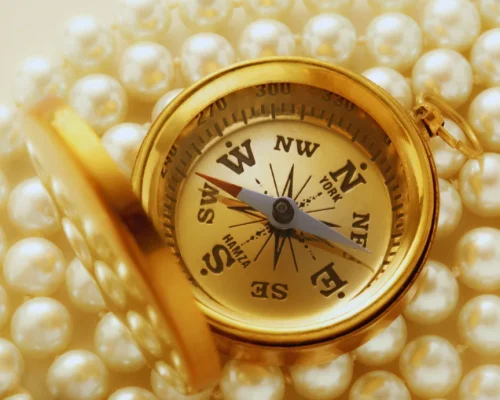
While fashion cycles through fleeting trends, pearls have remained an enduring symbol of sophistication for generations. Their luminous, subtly shifting radiance complements virtually any attire or skin tone. The organic spectrum of pearl hues effortlessly enhances every complexion, making them a universally flattering accessory.
Unlike other gemstones extracted from mines, pearls are naturally produced by living organisms, making them one of the most sustainable gemstones. Their cultivation also provides economic opportunities for coastal communities. Like snowflakes, no two pearls mirror each other perfectly – their organic contours, tactile surfaces, and iridescent hues bear the signature of nature. These living gems, when nurtured with devotion, become timeless conduits of beauty, passed down through generations as luminous family treasures. With a wide range of pearls to choose from, which pearl is the best?
How to classify pearls?
In general, pearls are classified by their type of origin. The primary step involves categorizing the pearl according to its source and method of formation.
Natural pearls vs. cultured pearls:
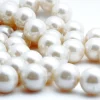
Features | Natural Pearls | Cultured Pearls |
Formation | A natural pearl forms spontaneously in nature when a foreign substance – like a parasite, worm, or shell fragment – accidentally lodges itself into a mollusk’s soft tissue. In response, the mollusk coats the irritant with layers of nacre, a protective secretion, gradually forming a pearl over time. | A cultured pearl is produced through human intervention in a farm setting, where pearl experts insert a nucleus (either a bead or mantle tissue) into the mollusk’s body to stimulate nacre secretion. This process mimics natural pearl formation but occurs under controlled conditions to optimize quality and yield. |
Nucleus | In natural pearls, the nucleus is the initial foreign particle that prompted the mollusk to secrete nacre around it. Since these irritants seldom form perfect spheres, natural pearls typically exhibit irregular shapes. | In cultured pearls, the nucleus is typically crafted from freshwater mussel shells, promoting the formation of a more uniform and frequently spherical shape. |
Timeframe | Typically range from 6 months to 7 years. | Typically range from 6 months to 3 years, with longer cultivation periods yielding higher quality, larger pearls. |
Rarity | Exceptionally rare, fewer than 1 in 10,000 wild oysters yield a gem-quality pearl. Additionally, overharvesting has severely reduced natural pearl populations. | The pearls are abundant and easy to obtain, with controlled farming practices ensuring dependable production of excellent-quality pearls through sustainable methods. |
Value | Natural pearls are far more valuable than cultured pearls because of their extreme rarity and historical importance. Premium-quality natural pearls can command prices well into six figures or even higher. | While premium cultured options such as South Sea pearls carry higher price tags, they remain significantly more affordable than natural pearls of comparable quality. |
Shape | Natural pearls are typically irregular in shape, often asymmetrical or misshapen -qualities that have led them to be called “baroque”. Perfectly round natural pearls are extremely rare. | Due to the shape of the implanted bead nucleus, it frequently appears more perfectly round and symmetrical. |
Luster | Typically possess a profound, refined, and satin-like sheen. | They commonly possess a brighter, more metallic sheen with mirror-like reflectivity, especially in top-tier varieties. |
Composition | Composed entirely of concentric layers of nacre deposited around the original irritant, which is typically quite tiny. | A bead-nucleated pearl typically has a thinner outer layer of nacre, whereas freshwater cultured pearls are usually entirely made of solid nacre. |
Identification | The only conclusive method for identification is X-ray examination conducted by a certified gemologist. The X-ray image will reveal concentric growth rings within the pearl, confirming the absence of a central nucleus. | X-ray imaging can detect a spherical, solid bead core surrounded by a thin nacreous coating. Additional gemological examination methods are also applicable. |
Saltwater pearls vs. freshwater pearls:
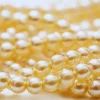
Features | Saltwater Pearls | Freshwater Pearls |
Origin | Cultivated in saltwater oysters inhabiting sheltered marine environments such as bays and lagoons. Primary production regions include Japan (Akoya pearls), French Polynesia (Tahitian pearls), and Australia (South Sea pearls). | Cultivated primarily in China, these mussels thrive in freshwater habitats such as rivers, lakes, and ponds. |
Luster | Renowned for their razor-sharp brilliance and mirror-like sheen, these pearls owe their extraordinary radiance to the unique layering process. Microscopically thin layers of nacre are meticulously deposited around a spherical bead nucleus, creating a luminous surface that reflects light with dazzling intensity. | With a thicker solid nacre composition, they exhibit a softer, satin-like glow with a hint of dewiness. |
Shape | While typically rounder and more symmetrical than freshwater pearls, baroque forms are also produced. | Most freshwater pearls develop around a small piece of tissue and are rarely perfectly round. Instead, they exhibit diverse shapes such as off-round, oval, and baroque. |
Nacre | Feature a thinner nacre outer layer over a spherical bead core, resulting in a more delicate structure. | With no bead nucleus and made entirely of solid nacre, these pearls have a thicker nacre layer that makes them more durable and less prone to chipping. |
Color | Have natural colors specific to their type. For example, Akoya pearls are white, Tahitian pearls are dark, and South Sea pearls are white or golden. | They are naturally found in a diverse range of pastel shades, including white, pink, peach, and lavender, while black freshwater pearls are usually artificially colored. |
Production | Saltwater oysters generally form a single pearl per individual due to their biological defense mechanism against irritants, which involves secreting nacre layers around foreign particles. | With each freshwater mussel capable of generating several pearls simultaneously, these pearls are produced in large quantities and remain affordable. |
Value | Command higher prices due to rarity and cultivation challenges. | Generally lower priced because of mass production capabilities and extensive shape selection. |
Specific pearl types:
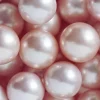
Features | Akoya pearls | South Sea pearls | Tahitian pearls | Freshwater pearls |
Origin | Coastal estuaries and tidal channels, mainly located in Japan and China. | Saltwater bays off the coast of Australia, Indonesia, and the Philippines. | Saltwater lagoons of French Polynesia. | Freshwater rivers, lakes, and ponds, primarily in China. |
Host mollusk | The Pinctada fucata oyster. | The Pinctada maxima oyster, a large species that includes both silver-lipped and gold-lipped varieties. | The black-lipped Pinctada margaritifera oyster. | Various species of freshwater mussels. |
Color | Dominated by classic white and cream tones, often accented with subtle rose or silver highlights. | These oysters exhibit natural white, silver, and golden tones without any treatment, unlike many other types that are often artificially colored. | The only naturally formed dark-hued pearls exhibit a spectrum of colors spanning black and gray to vibrant iridescent shades such as peacock green, aubergine purple, and deep blue | Known for a diverse range of natural colors, including white, pink, lavender, and peach. Black varieties are typically dyed. |
Shape | Akoya pearls, a type of saltwater pearl, are renowned for their consistently near-perfect spherical shape. Among pearl shapes, flawless roundness commands the highest market value. | While available in many forms, flawless round specimens command the highest value. | While they can be perfectly round, they are equally renowned for their unique baroque and semi-baroque forms. | Typically irregular and less round than saltwater varieties, though advances in modern culturing have produced high-quality, perfectly round pearls. |
Size | The typical size range for these pearls is 3–9.5 mm in diameter. Their compact dimensions and consistent formality render them ideal for traditional pearl strands and stud earring designs. | The largest of all cultured pearls, ranging from 8 mm to over 20 mm. | Larger than Akoya pearls, typically ranging from 8 to 14 mm. | Generally smaller than saltwater pearls, ranging from 2 to 15 mm. |
Nacre | They have thinner nacre compared to South Sea pearls. | With an average nacre thickness of 2 to 6 mm, they surpass all other cultured saltwater pearls in this regard. | The export regulations from French Polynesia mandate a minimum nacre thickness of 0.8 mm. | Unlike saltwater pearls that are bead-nucleated, most cultured freshwater pearls are tissue-nucleated and consist almost entirely of solid nacre. |
How are pearls graded?
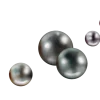
Pearls are evaluated through multiple criteria, including luster, surface quality, shape, size, thickness of nacre, compatibility, and color; however, there is no globally unified grading system in the pearl industry.
How much are real pearls worth?
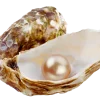
The price of a real pearl varies significantly, from less than $100 to several million dollars, influenced by factors such as origin (natural vs. cultured) and specific attributes. Natural pearls, being extraordinarily scarce, command the highest prices, whereas cultured pearls – accounting for more than 99% of the market – offer greater affordability.
Freshwater pearls: Ranging from about $50 to over $2,000 for a freshwater pearl strand necklace, making them the most accessible and commonly available option on the market.
Akoya pearls: Renowned for their classic round white luster, predominantly sourced from Japan and China, command a price range spanning approximately $300 to over $10,000 per strand.
Tahitian pearls: Known for their naturally dark colors – ranging from black and green to peacock tones – with strands typically starting at around $500 and can reach over $25,000.
South Sea pearls: Considered the finest cultured pearls available, their per-strand pricing spans from approximately $1,000 to more than $100,000.
How do I tell if my pearls are real?
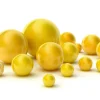
The authenticity of pearls can be identified from the following aspects:
Appearance identification
Luster: The luster of real pearls is soft and natural. When viewed from different angles, it shows subtle changes and is accompanied by a lustrous sheen. Fake pearls have a dazzling and stiff luster, and their color is uniform without any change.
Surface flaw: The surface of real pearls has natural growth lines and minor flaws. The surface of fake pearls is smooth and flawless, and their shapes are overly regular.
Color: The color of real pearls naturally varies in depth. Fake pearls have uniform and heavy colors, such as green, red, and other rare colors in nature, which should be taken seriously.
Drill holes: The drill holes of real pearls are small, with sharp edges and visible layered structures inside. Fake pearls have large holes, rough edges, and the coating is prone to peeling off.
Tactile identification
Temperature: Real pearls feel cool to the touch. Even after holding them for a few seconds, they still feel cool. The temperature of fake pearls is similar to that of the environment, and they quickly become warm.
Weight: Real pearls have a higher density and feel heavier. Fake pearls are light, especially plastic ones.
Rubbing: When two real pearls are rubbed, they make a rustling sound. With a little force, pearl powder can be ground out. Fake pearls become slippery when rubbed and have no sandy feel.
Professional identification
Magnifying glass: The surface of real pearls has growth lines like grooves, and the boundary line between the nacre and the nucleus can be seen in the holes. The surface of fake pearls is smooth, without growth marks, and the coating is uniform.
Refractive index: The refractive index of real pearls is between 1.530 and 1.685. The refractive index of fake pearls is abnormal.
Identification institution: It can be sent to a professional appraisal institution, such as NGTC, to obtain an authoritative certificate.
Note: Avoid using a single method for identification. Burning, scratching with a knife, etc., may damage the pearls. It is recommended to give priority to professional identification. When encountering unusually low-priced pearls, heightened vigilance is essential. Authentic pearls inherently possess greater value, and significantly discounted options are often counterfeit.
What to look for when buying pearl jewelry?
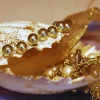
When selecting pearl jewelry, key factors to evaluate include:
Luster – Assess the pearl’s glow by checking how clearly your reflection appears on its surface.
Surface quality – While flawless surfaces are ideal, minor blemishes can naturally occur during growth.
Shape – Perfectly round pearls are rare, but semi-round and baroque shapes offer a unique aesthetic appeal.
Color – Choose based on personal preference and skin tone compatibility (e.g., light skin pairs well with white/pink pearls).
Size – Ranges from 5-16mm, with South Sea pearls typically being the largest variety.
Nacre thickness – Thicker nacre layers enhance durability and luster quality.
Craftsmanship – Pay attention to jewelry settings and matching when purchasing multi-piece sets.
Occasion – You should also take occasion into consideration when choosing pearl jewelry. Larger pearl stud earrings and necklaces, with their bold presence, are typically reserved for formal events like business galas, charity balls, black-tie banquets, and wedding ceremonies. These statement pieces complement structured silhouettes and eveningwear. Conversely, petite pearl studs and delicate necklaces offer understated elegance that seamlessly transitions from workplace attire to weekend brunch, making them wardrobe staples for daily sophistication.
Every exquisite pearl at Wang Jewelry is ethically sourced from our trusted pearl farms. Our master pearl designers then hand-select each gem, transforming it into a unique work of art through meticulous craftsmanship. Each piece carries the passion of pearl farmers and the artistry of our designers – a perfect blend of nature’s beauty and human expertise. Discover your next timeless treasure today at Wang Jewelry!
